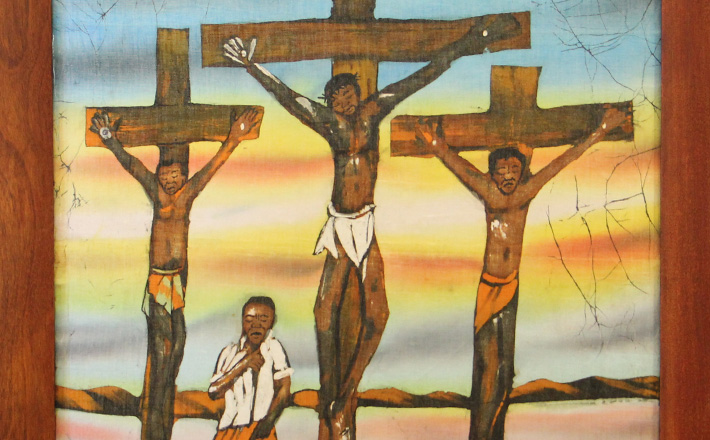Commentary on Luke 23:32-47
In the Gospel of Luke, the most common title used for Jesus is kyrios, “Lord.” This did not necessarily imply divinity at the time; slavemasters and heads of households were also called kyrios. Jesus’ lordship, however, clearly means more for Luke than mere human authority. Jesus is repeatedly shown healing, exorcising demons, even raising the dead (Luke 7:11-17). The Romans executed him not because they believed he deserved death, but because they feared his power.
The Roman prefect Pilate and the Jewish king Herod declare Jesus innocent three times (verses 4, 14, 22). Professions of Jesus’ innocence continue throughout the ensuing scenes: a criminal crucified with Jesus declares him undeserving of death (verse 41), a Roman centurion declares him innocent (literally, “righteous,” verse 48), observers beat their breasts in remorse (verse 48), and the Temple curtain is torn in two, a symbol of mourning (not, as some suggest, to indicate new access to God; verse 45; see Genesis 37:29, 34; Exodus 26.31-35; 44:13; Joshua 7:6).
Despite recognizing that Jesus is innocent, Pilate nevertheless delivers the deadly verdict (verses 24-25): this man is an insurrectionist whose power threatens Rome. The threat of rebellion must be extinguished.
This twisted justice is enacted on Golgotha, the place of the “skull” (verse 33). It was a common spot for Roman executions, strategically positioned as a warning to onlookers. The Romans were not the only Empire to use crucifixion as a means of social control. Alexander the Great of Macedonia reportedly had 2,000 survivors crucified after the siege of Tyre in 332 BCE and left them on display for all to see; there are reports that Soviet forces crucified their opponents as recently as World War II.
Crucifixions are a sobering reminder to survivors to stay in line. In the first-century Roman Empire, it was employed in the service of the famous “Pax Romana,” the Roman Peace. Ironically, if not surprisingly, their means of ensuring peace was violence. Violence was the Roman way. And even if they could not see it, the Romans’ own humanity was diminished by the ways they dehumanized and sought to control others.
Too often, twisted justice and violence are also the American way. Too often, like the criminal crucified next to Jesus (verse 41), we divide people into those deserving of power or punishment. Our worldly concepts of justice are not so different from the Roman practices on display in Luke 23:32-47. We, too, try to hold power with violence in the name of justice. And as a result, our humanity, too, is diminished.
This is not God’s definition of justice. God’s justice does not seek punishment or ensure “peace” through violence and abuse of power. This is the lesson of the crucifixion. The cross is the ultimate paradox: divine power displayed through weakness, justice achieved through an innocent victim’s willingness to suffer, so that through death, new life could illuminate a dark world.
Unfortunately, even Jesus’ example of willingly undergoing suffering without fighting back has been distorted to justify oppression. Many Christians have used the call to emulate Christ to argue that victims of abuse should stay silent and submit without complaining. This argument was used by American slaveholders in the antebellum south; it continues to be used today by those who argue that those suffering from domestic abuse ought not leave or try to seek help. But this is not the spirit of God’s Spirit. The two greatest commandments are to love God and love our neighbor as ourselves (Luke 10:26-28; see also Matthew 22:38-39). Love for God, neighbor, and self will never justify injustice. Real authority—true power—always walks with people through death all the way into new life; it never stops on the cross or in the tomb.
Jesus’ final words on the cross in Luke, “Father into your hands I commend my spirit” (verse 46), come from Psalm 31:5. Some read this as an instance of metonymic referentiality—that is, when a brief reference evokes the larger original context in which an explicit quotation is found. Psalm 31 is a prayer for vindication from one’s enemies; if this is indeed metonymic referentiality, then Jesus’ cry evokes not only a sense of completion and finality as Jesus “breathed his last” (verse 47), but also a continued hope that the God who is our “refuge” (Psalm 31:4) will yet intervene to ensure that justice is done.
God’s justice is powerful because it is also merciful. God calls for a discipleship that loves mercy and does justice at the same time: “He has told you, oh man, what is good and what the Lord desires of you—that you love mercy and do justice and walk humbly with your God” (Micah 6:8). In God’s kingdom, no one “deserves” payback or retribution because no one is abusing power or taking advantage of anyone else.
The irony of the cross is that there is a quiet but much more profound power to be found in holding justice and mercy together. In his powerful little book, The Promise of Paradox, Parker Palmer writes:
“The cross says, ‘the pain stops here.’ The way of the cross is a way of absorbing pain, not passing it on, a way that transforms pain from destructive impulse into creative power. When Jesus accepted the cross, his death opened up the channel for the redeeming power of love.”
This nonviolent redeeming power has been channeled into many of the major social movements of the past two thousand years: public education, children’s rights, the abolition of slavery, civil rights, women’s suffrage, the establishment of soup kitchens and hospitals. Often, these movements were spearheaded by Christians who were seeking to embody both justice and mercy.
Of course, none of these movements was perfect, and all remain unfinished. Twisted justice and violence continue to plague us; too many still hang on crosses, held there by the nails of racism, sexism, abuse, and other forms of dehumanization.
May our preaching be measured against this test: Does the gospel we proclaim pervert justice and perpetuate pain, or does it transform pain into redemptive life-giving power? Over and against the dehumanizing violence and injustice of the world, may we proclaim instead the way of the cross—the merciful, just, and powerful way of Christ.
PRAYER OF THE DAY
Redeeming Creator,
Dust and rocks groan. Deserts and prairies weep. Bushes and trees moan. Rivers and oceans roar. Animals of land, sea, and sky recoil. Sun cowers and moon wanes. Humanity fails. And darkness laughs. But it will not have its way with us forever. Amen.
HYMNS
Ah, holy Jesus ELW 349, H82 158, UMH 289, NCH 218
Jesus, remember me ELW 616, UMH 488
On my heart imprint your image ELW 811
CHORAL
Crucifixus, Antonio Lotti


April 2, 2021